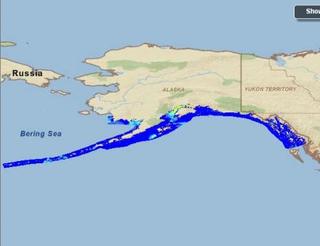Alaska Shows Greatest Potential for Ocean Energy Development

Friday, January 20 2012
With its lengthy stretches of coast line, rapid currents, and big waves, Alaska could be capable of producing about a fifth of the nation’s electricity. That’s according to two new reports released by the United States Department of Energy that find that the state’s waters have enough energy in them to produce over 850 terawatt hours of electricity every year -- that’s enough to run over 800 billion space heaters all day, year round.
Right now, only about 6 percent of the nation’s electricity comes from hydropower resources. The Department of Energy is aiming to boost water power usage up to 15 percent by 2030.
Mike Reed is the team leader for DOE’s water program, and he says the development of ocean energy could be a big part of meeting that objective.
“We believe that ocean energy is one of the few remaining options that has yet been taken advantage of to pursue clean energy options for the United States,” says Reed. “We’re aggressively pursuing wind, geothermal, and some other technologies. But ocean energy has largely been untapped and yet represents a terrific opportunity to meet our nation’s clean energy goals”
According to one assessment, the most productive regions in Alaska are Akutan, Unalga, and Samalga passes in the Aleutians, Cook Inlet, and Bristol Bay. According to water program staffer Hoyt Beatty, Alaska’s coastal and island communities are uniquely positioned to take advantage of ocean energy.
“The resource is there, and given the distribution of coastal communities in Alaska, I think it has one of the highest potentials for near-term development of the technology in the next few years,” says Beatty.
However, while Alaska’s waters are capable of producing plenty of energy, developing it all wouldn’t be cost-effective, especially in sparsely populated regions. Mike Reed says that DOE is conducting a technical and economic assessment of what developing ocean energy would entail, and how much potentially energy could realistically be harnessed.
“Cost is one of the biggest challenges. As with any technology, the first-of-its-kind devices are very expensive, but as you develop the second and third generation machines, they tend to be much more competitive,” says Reed.
The Department of Energy is also studying the potential development of river energy and ocean tides energy, and those reports are expected to come out later this year.




stephanie on Saturday, January 05 2013:
this didnt help at all losers